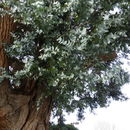pt-BR
nomes no trilho de navegação


Eucalyptus crenulata (lat. Eucalyptus crenulata) - mərsinkimilər fəsiləsinin evkalipt cinsinə aid bitki növü.
Eucalyptus crenulata, commonly known as Buxton gum, silver gum or Victorian silver gum,[2] is a rare species of medium-sized tree that is found only in the wild in a small area in Victoria but is widely planted. It has rough, compacted bark on the trunk, sessile, egg-shaped to heart-shaped leaves arranged in opposite pairs, flower buds covered with a white, powdery bloom, white flowers and cup-shaped fruit.

Eucalyptus crenulata is a tree that typically grows to a height of 10–12 m (30–40 ft) and forms a lignotuber. It has hard, rough, compacted, grey to brown or black bark on the trunk and smooth grey or yellowish bark on the branches. The leaves on young plants and coppice regrowth are egg-shaped to heart-shaped, arranged in opposite pairs, paler on the lower surface, 20–65 mm (0.79–2.6 in) long, 15–55 mm (0.6–2 in) wide and lack a petiole. The adult leaves are similar to the juvenile leaves except that the juvenile leaves are covered with a powdery white bloom that eventually wears off. The edges of the leaves have small, rounded teeth. The flower buds are arranged in groups of seven, nine or eleven in leaf axils on an unbranched peduncle 1–8 mm (0.04–0.3 in) long, the individual buds on a pedicel 1–4 mm (0.04–0.2 in) long. The mature buds are oval to almost spherical, covered with a powdery bloom, 5–7 mm (0.20–0.28 in) long and 3–4 mm (0.12–0.16 in) wide with a beaked operculum. Flowering occurs from September to February and the flowers are white. The fruit is a woody cup-shaped capsule 3–5 mm (0.12–0.20 in) long and 4–6 mm (0.16–0.24 in) wide on a pedicel up to 3 mm (0.1 in) long with the valves enclosed below the rim.[2][3][4][5]
Eucalyptus crenulata was first formally described in 1939 by William Blakely and Wilfred de Beuzeville from a specimen collected near Buxton. The description was published in Contributions from the New South Wales National Herbarium.[6] The specific epithet (crenulata) is a Latin word meaning "having small, rounded teeth", referring to the scalloped leaf edges.[7]
Buxton gum grows in swampy sites in the foothills of the Great Dividing Range. It is only known from two natural populations, one near the Acheron River valley near Buxton and the other on the Yarra River floodplain at Yering in Victoria, Australia. The species is widely cultivated however, and there are many more specimens in cultivation than in the natural environment.[2][4][5]
Eucalyptus crenulata is listed as "endangered" under the Australian Government Environment Protection and Biodiversity Conservation Act 1999 and as "threatened" in Victoria under the Flora and Fauna Guarantee Act 1988.[4][5]
Eucalyptus crenulata, commonly known as Buxton gum, silver gum or Victorian silver gum, is a rare species of medium-sized tree that is found only in the wild in a small area in Victoria but is widely planted. It has rough, compacted bark on the trunk, sessile, egg-shaped to heart-shaped leaves arranged in opposite pairs, flower buds covered with a white, powdery bloom, white flowers and cup-shaped fruit.
 Habit near the U.N.E.
Habit near the U.N.E. fruit
fruit bark
bark
Eucalyptus crenulata, comúnmente conocido como el eucalipto Buxton (Buxton gum) o eucalipto de plata (silver gum), es una especie de eucalipto endémico del valle del Río Acheron en Victoria en Australia.
Es un pequeño árbol con denso follaje que raramente excede los 8 metros de altura. Tiene las hojas glaucas verde-azulosas con los márgenes crenulados. La especie está enlistada como "amenazada" en Victoria[1]
Eucalyptus crenulata fue descrita por Blakely & Beuzev. y publicado en Contributions from the New South Wales National Herbarium 1: 37. 1939.[2]
Eucalyptus: nombre genérico que proviene del griego antiguo: eû = "bien, justamente" y kalyptós = "cubierto, que recubre". En Eucalyptus L'Hér., los pétalos, soldados entre sí y a veces también con los sépalos, forman parte del opérculo, perfectamente ajustado al hipanto, que se desprende a la hora de la floración.[3]
crenulata: epíteto latíno que significa "crenado, con pequeños dientes redondeados".[4]
Eucalyptus crenulata, comúnmente conocido como el eucalipto Buxton (Buxton gum) o eucalipto de plata (silver gum), es una especie de eucalipto endémico del valle del Río Acheron en Victoria en Australia.
Eucalyptus crenulata est une espèce d'eucalyptus endémique de la vallée de la rivière Acheron, au Victoria, en Australie.
C'est un petit arbre avec un feuillage dense qui dépasse rarement 8 mètres de hauteur. Il a des feuilles glauques bleu-vert avec des bords crénelés.
L'espèce est classée comme « menacée » dans l'état de Victoria, en vertu du Flora and Fauna Guarantee Act 1988.
Eucalyptus crenulata a, pour la première fois, été décrit en 1939 par William Blakely et Wilfred de Beuzeville d'après un spécimen récolté près de Buxton.
La description a été publiée dans Contributions from the New South Wales National Herbarium[1]. L'épithète crenulata est un mot latin signifiant « avec de petites dents arrondies », se référant aux bords des feuilles festonnées[2].
Eucalyptus crenulata est une espèce d'eucalyptus endémique de la vallée de la rivière Acheron, au Victoria, en Australie.
Eucalyptus crenulata là một loài thực vật có hoa trong Họ Đào kim nương. Loài này được Blakely & Beuzev. mô tả khoa học đầu tiên năm 1939.[1]
Eucalyptus crenulata là một loài thực vật có hoa trong Họ Đào kim nương. Loài này được Blakely & Beuzev. mô tả khoa học đầu tiên năm 1939.